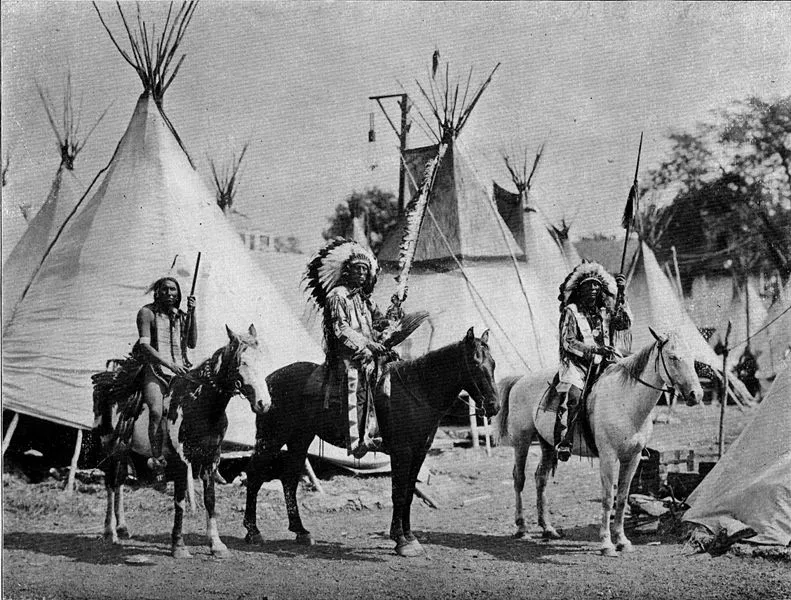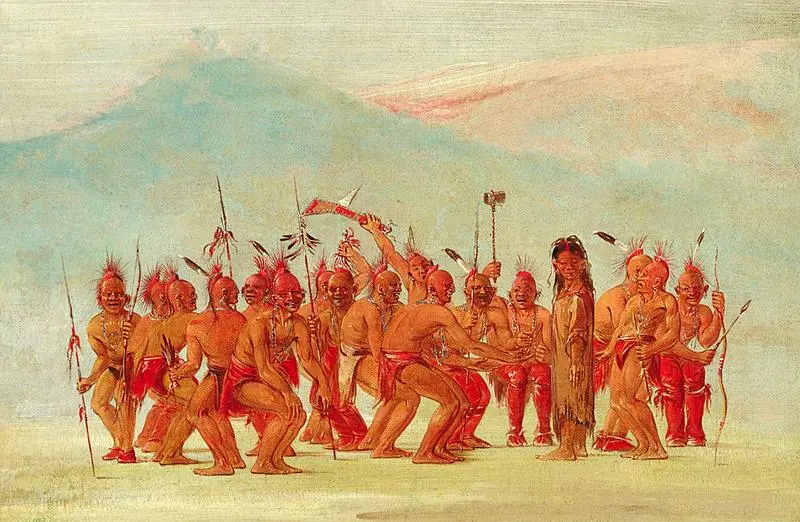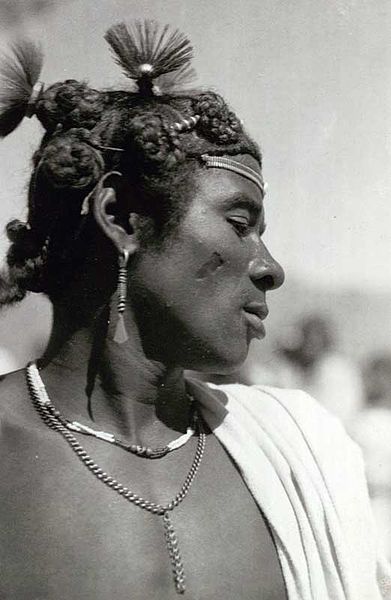American Indian Woman Who Dressed as a Man
 "A Glimpse at the Indian Congress – There are forty-two tribes of North American Indians represented in the Indian Congress. Three of the most noted chiefs are seen in this group. To the extreme left is Chief Lone Elk, Sioux, and in the center is Chief Red Cloud, the fierce war chief of the Sioux, fiery orator and bitter enemy of the whites. To the right is Chief Hard Heart, another noted Sioux warrior." Source: C. D. Arnold/Wikimedia Commons
"A Glimpse at the Indian Congress – There are forty-two tribes of North American Indians represented in the Indian Congress. Three of the most noted chiefs are seen in this group. To the extreme left is Chief Lone Elk, Sioux, and in the center is Chief Red Cloud, the fierce war chief of the Sioux, fiery orator and bitter enemy of the whites. To the right is Chief Hard Heart, another noted Sioux warrior." Source: C. D. Arnold/Wikimedia Commons
Before the advent of Europeans, Native Americans, embraced gender fluidity. There were no gender binaries. There were men and women, and then there were feminine men and manly women, and transgendered individuals. In native North American societies, these individuals were considered to be 'normal'. In fact, those who adopted fluid gender roles were called Two Spirit female and Two Spirit male; and were considered supremely gifted, having the knowledge and ability to understand two opposing sides. There were no defined rules, no distinct binaries. In these societies, men and women frequently assumed opposite gender identities, occasionally cross-dressing, but almost always adopting the universal occupational roles assigned to each sex.
However, when the god-fearing, ubiquitously rigid Christian Europeans invaded the land occupied by the native Americans, the former was appalled by the openness the natives displayed when it came to expressing their sexuality. In the Euro-Western cultural tradition, gender diversity was sacrilege; there were no alternative categorizations, no room for homosexuality or transvestites. Thus, the Two Spirit individuals, who were locally revered and respected, were relegated to being called sodomites by the Spanish conquistadors. Early French explorers, called them 'berdache', which was derived from 'badaj', a Persian word meaning 'intimate male friend'. Invariably, the word had homosexual connotations.
A paper titled The North American Berdache, described berdache "as a person, usually male, who was anatomically normal but assumed the dress, occupations, and behavior of the other sex to effect a change in gender status. This shift was not complete; rather, it was a movement toward a somewhat intermediate status that combined social attributes of males and females. The terminology for berdaches defined them as a distinct gender status, designated by special terms rather than by the words "man" or "woman'…Although "berdache" originally designated a male, its etymology became irrelevant long ago, and it is used here for both sexually."
 Drawn while on the Great Plains, among the Sac and Fox Indians, the sketch depicts a ceremonial dance to celebrate the two-spirit person. By George Catlin (1796-1872). Source: Wikimedia Commons
Drawn while on the Great Plains, among the Sac and Fox Indians, the sketch depicts a ceremonial dance to celebrate the two-spirit person. By George Catlin (1796-1872). Source: Wikimedia Commons
Subscriber Only Stories
Historical documents suggest that at least 113 native American tribes adopted berdachism. In these indigenous societies like the Navajo, a 'feminine man' would not be solely perceived as a woman, but as a man and a woman, and would be called 'nádleehí'. Similarly, the native Hawaiian culture revered the mahu people – those who possess both the male and female spirits. However, the Europeans determinedly worked towards obliterating these fluid genders, and berdaches slowly began to disappear due to the oppressive hostility of the outsiders. In effect, the natives became reticent about their cultural openness, succumbing to the rules laid down by the westerners.
Ethnographic research reveals therefore, that prior to the European dominance, there were absolutely no monolithic gender systems in place. The construction of two specific gender identities as non-interchangeable absolutes, was in fact, the invention of the Euro-Western society, carefully built into the patriarchal framework.
Gender diversity is prevalent in other societies as well:
MAYANMAR
Similar to the native Americans, Acaults are those who are biologically male, but cross-dress as women and socially adopt female roles. They are respected in Burmese society, because they are considered to be 'gifted' seers, often functioning as mediums for outwardly spirits and other supernatural activities intrinsic to indigenous Burmese culture.
INDIA
In India, the aravanis (named after the brides of the mythological figure, Aravan) who are a subset of the hijra community, are those who are although biologically male, but adopt a female identity. Aravan finds a mention in the Mahabharata. When the Pandavas wanted to conquer Kurukshetra, they had to sacrifice the 'perfect' man, and the unmarried virgin Aravan stepped up to be beheaded. However, he wanted to die as a married man after consummating marriage. None of the kings though, wanted to offer their daughters, who would be widowed the next day. So, Krishna transformed into a woman to fulfill Aravan's last wish. After making love to the female form of Krishna, Aravan was beheaded.
 Dancer and medicine man from the Antandroy tribe. Source: Wikimedia Commons
Dancer and medicine man from the Antandroy tribe. Source: Wikimedia Commons
MADAGASCAR AND SAMOA
The Sakalavas, an ethnic group that constitute to 6.2 per cent of Madagascar's population bring up certain boys as girls, if they are considered to physically look feminine. Within this group, the Antandroy and Hova tribes, for example, raise their boys as "real women" by braiding their hair, piercing their ears and making them wear jewelery all over their body. They are taught how to converse in a woman's voice and socially behave like women. In effect, the fact that they are biologically men is completely forgotten.
Similarly in Samoa, Fa'afafine are children who although are biologically male, exhibit feminine characteristics, which the parents recognise early on. Therefore, they are raised as girls. Even though Fa'afafine grow up to be sexually involved with men and women, it is important to note that fa'afafine are not considered to be 'homosexuals' – that, is an entirely an Euro-Western construct.
AFGHANISTAN
Afghanistan is deeply patriarchal and conservative country which is considered to be one of the worst regions for women. An underground tradition called Bacha posh – which literally translates to a girl "dressed as a boy" – are girls who are brought up secretly by their parents as boys in order to survive in a male-dominated world. This tradition seems to have existed in small pockets since the time Islam took over the country.
EGYPT
During the period from the 1200s to 1500s, during the reign of Mamluk period, girls who were considered to behave like boys, were raised as men, and therefore could enjoy all the privileges men could in society.
HAWAII
Regardless of their anatomical identities, the Mahus' gender identity was not restricted to definitive masculine or feminine. In the Hawaiian indigenous culture, the Mahus were considered to be the vocal mediums for proliferating ancient rituals and were respected as educators. The invasion of the Europeans led to the disintegration of the Mahus, and today they experience extreme discrimination, since their existence contradicts the established and prevailing European gender binaries.
THAILAND
In Thailand, of course, there are the 'kathoeys' or 'katoeys', who are more commonly known as ladyboys. These are transgender women who are respected in the country. They are not socially discriminated against, in fact, they are respected. Unlike transgenders who often lurk in the shadows in other countries, kathoeys are certainly more visible. A lot of them dance in cabarets and other shows.
altcamortautley53.blogspot.com
Source: https://indianexpress.com/article/world/indigenous-tribes-embraced-gender-fluidity-prior-to-colonisation-but-europeans-enforced-specific-gender-roles/
0 Response to "American Indian Woman Who Dressed as a Man"
Post a Comment